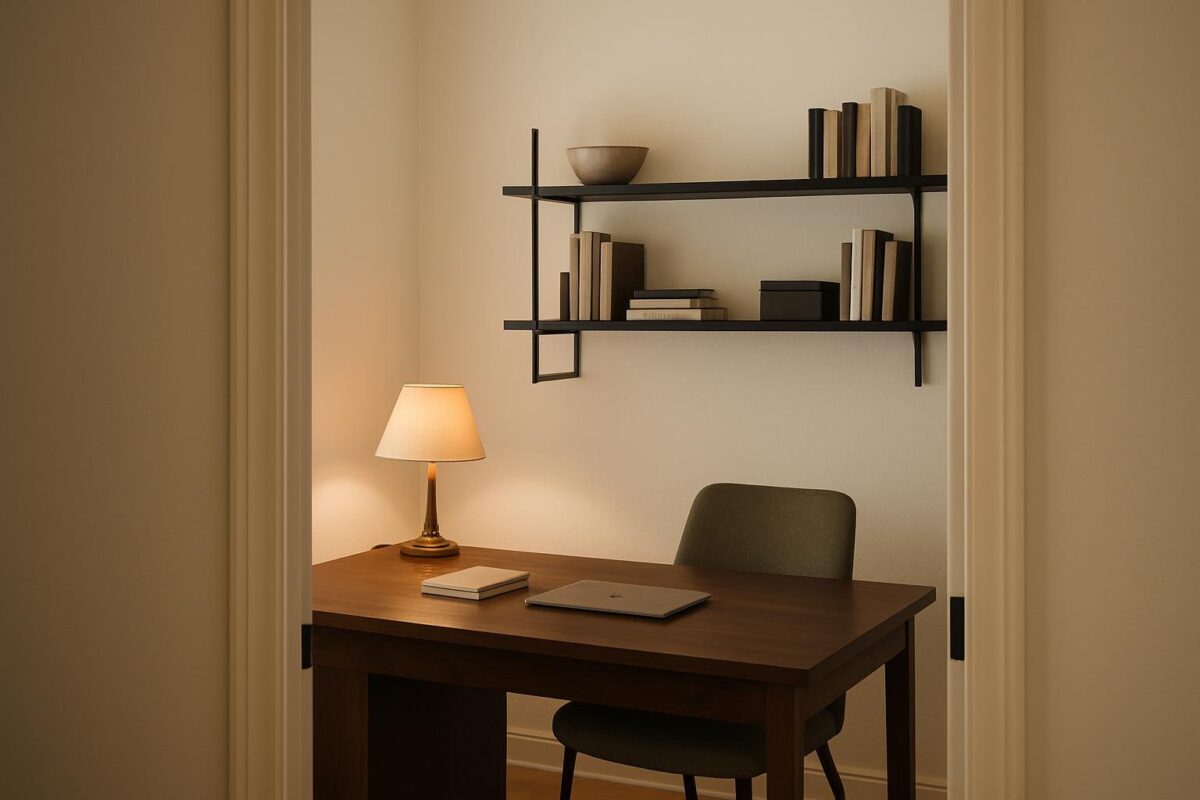A home office works best when it balances focus with comfort. Too much emphasis on function can make the space feel cold, while too much emphasis on style can create distractions. The key is to design a workspace that supports productivity while still feeling inviting enough to spend long hours in.
Simple choices like a warm-toned desk, a supportive chair, or thoughtful lighting can change how a space feels and performs. Color also plays a major role—muted greens, deep blues, or soft neutrals can set the tone for both concentration and calm. Storage and styling matter too, since clutter-free surroundings make it easier to stay organized.
By combining practical setups with small design details, anyone can create an office that feels purposeful without being sterile. The following approaches show how different combinations of furniture, color, and light can shape a workspace into one that encourages focus while remaining welcoming.
Walnut Desk And Olive Chair Warmth
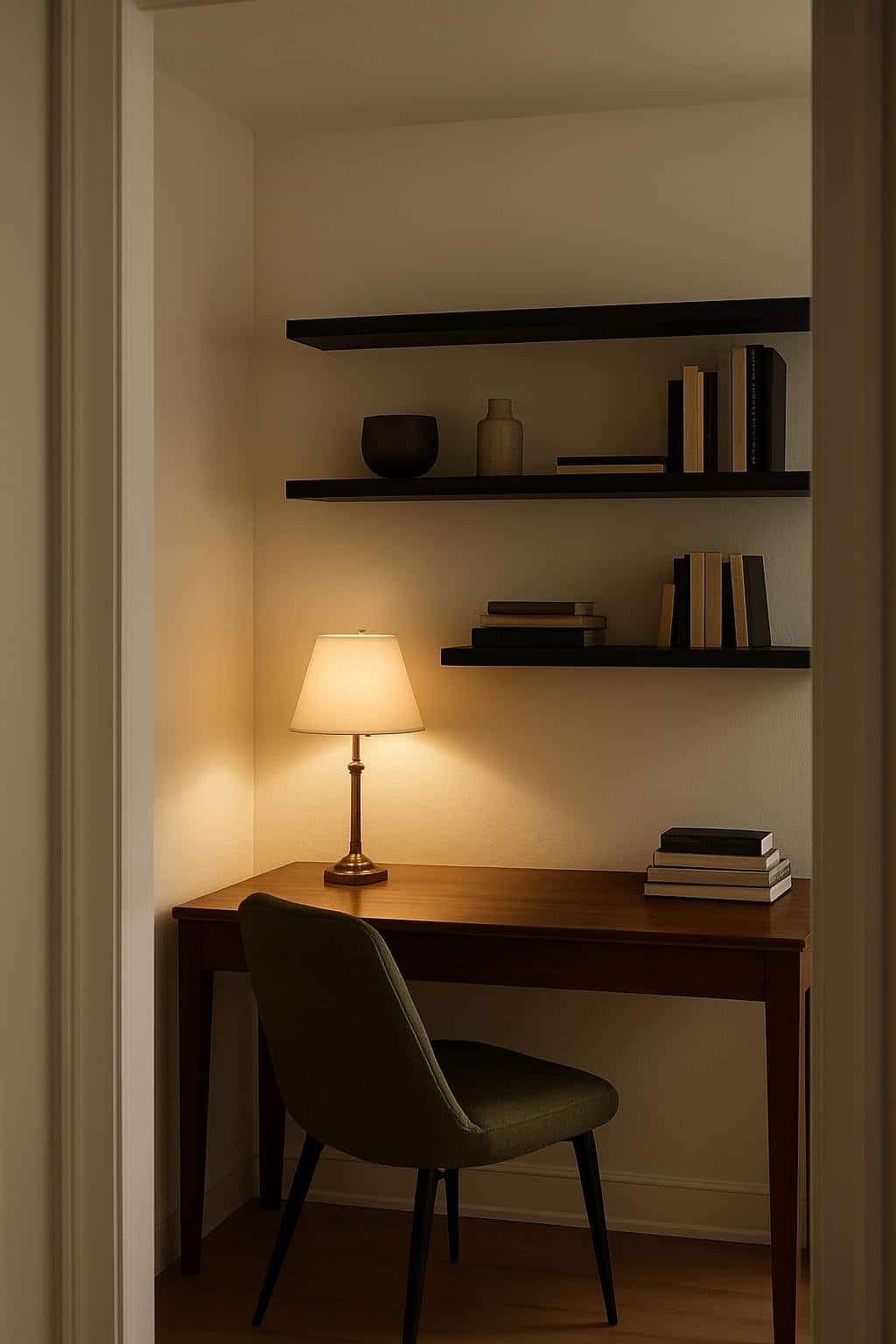
A workspace with walnut wood and olive upholstery creates a balanced environment that feels both professional and welcoming. The pairing of deep wood tones with muted green seating offers durability, comfort, and a natural sense of calm.
Rich Walnut Desk Adds Grounding Warmth
A walnut desk provides stability through its solid build and timeless finish. The dense grain and darker hues make it a practical choice for long-term use, as walnut resists warping and maintains its shape over time.
The surface works well with both minimal and layered setups. A matte monitor stand, leather desk pad, or glass overlay can protect the finish while complementing its natural texture. Walnut also pairs well with light wall colors such as cream or pale gray, which highlight the richness of the wood.
For those working with limited space, compact walnut desks with tapered legs or wall-mounted options offer functionality without overwhelming the room. Larger studios may benefit from solid slab designs or L-shaped walnut desks, which provide more surface area for dual monitors or shared work.
Olive Chair Introduces Soft Color
An olive-colored chair adds muted contrast against the darker walnut desk. The tone sits between green and gray, which makes it versatile across different lighting conditions. It introduces color without overwhelming the workspace, offering a subtle alternative to standard black or beige seating.
Upholstery choices matter. Faux leather provides easy cleaning, while woven fabric brings texture and breathability. Chairs with ergonomic padding or adjustable height ensure that the design choice does not compromise comfort.
Olive works especially well in rooms with natural elements—plants, linen curtains, or jute rugs. This creates a consistent palette that feels coordinated yet understated, making the chair both a functional seat and a soft accent piece.
Evening Lamp Light Makes The Space Cozy
Lighting completes the balance between walnut and olive. Warm-toned lamps in the 2700K–3000K range soften the darker wood and highlight the green tones of the chair. A desk lamp with a dimmer or a floor lamp with a fabric shade can adjust brightness as the day transitions into evening.
Placement matters. A lamp positioned slightly behind or to the side of the desk reduces glare on screens while casting a gentle glow across the workspace. Brass, black, or wood-based lamp finishes integrate well with the walnut desk’s tone.
Layered lighting—such as combining a desk lamp with a wall sconce—ensures the space remains functional while still inviting after dark. This approach avoids harsh overhead light and helps create an environment suited for both work and relaxation.
Bright Shelving With A Navy Pop
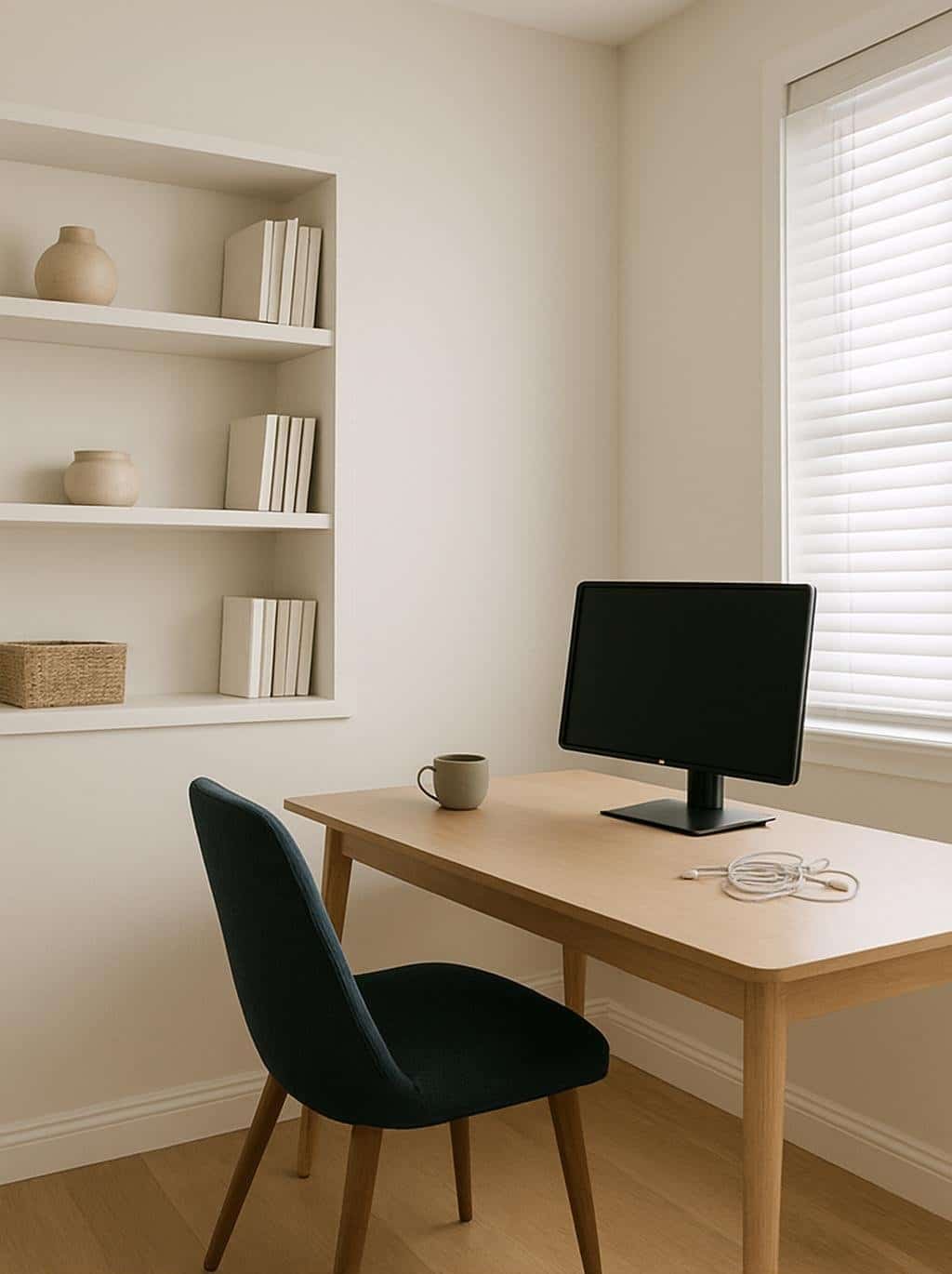
A workspace feels more functional when storage blends with design choices that add depth. Bright shelving, a strong accent chair, and controlled daylight work together to keep the room practical yet visually balanced.
White Shelving Brightens The Room
White shelving helps reflect available light, making the office appear larger and more open. Unlike darker finishes, it avoids adding visual weight to the walls, which can crowd a smaller space.
Shelves in a crisp white finish also provide a neutral backdrop for books, baskets, and decorative objects. This makes it easier to rotate accessories without clashing colors.
For organization, open shelving works best when paired with uniform storage bins. A row of woven baskets or labeled boxes keeps supplies accessible but prevents clutter from dominating the space.
Placement matters as well. Installing shelves above the desk keeps essentials within reach while leaving the desktop clear. Floor-to-ceiling shelving can maximize vertical storage without overwhelming the room when kept in a light finish.
Navy Chair Adds A Bold Accent
A navy chair introduces contrast without overpowering the room. The darker shade grounds the space and provides a visual anchor against the lighter shelving and walls.
Navy works especially well in offices because it conveys a sense of calm and focus. Unlike brighter accent colors, it doesn’t distract from work tasks yet still adds personality.
Material choice influences the effect. A fabric chair in navy softens the look, while a leather chair creates a more structured and formal appearance. Both options complement white shelving but produce different atmospheres.
Pairing the chair with brass or matte black hardware can tie the color into other elements of the room. Even a small detail, such as a navy cushion or throw, can reinforce the color scheme.
Cloudy Daylight Filters Through Blinds For Balance
Daylight is essential, but direct sun can create glare on screens. Using blinds allows filtered light that softens shadows and keeps the room comfortable throughout the day.
On overcast days, the muted light pairs well with white shelving, preventing the space from feeling dull. The shelving reflects available light, while the navy accent chair provides contrast that keeps the palette from looking flat.
Adjustable blinds or shades give control over brightness. Tilting slats slightly upward directs light toward the ceiling, spreading it evenly without harsh reflections.
For tasks requiring precision, a desk lamp with a neutral bulb temperature can supplement natural light. This combination ensures the office remains bright but balanced, whether the sky is clear or cloudy.
Golden Hour Glow On A Black Desk
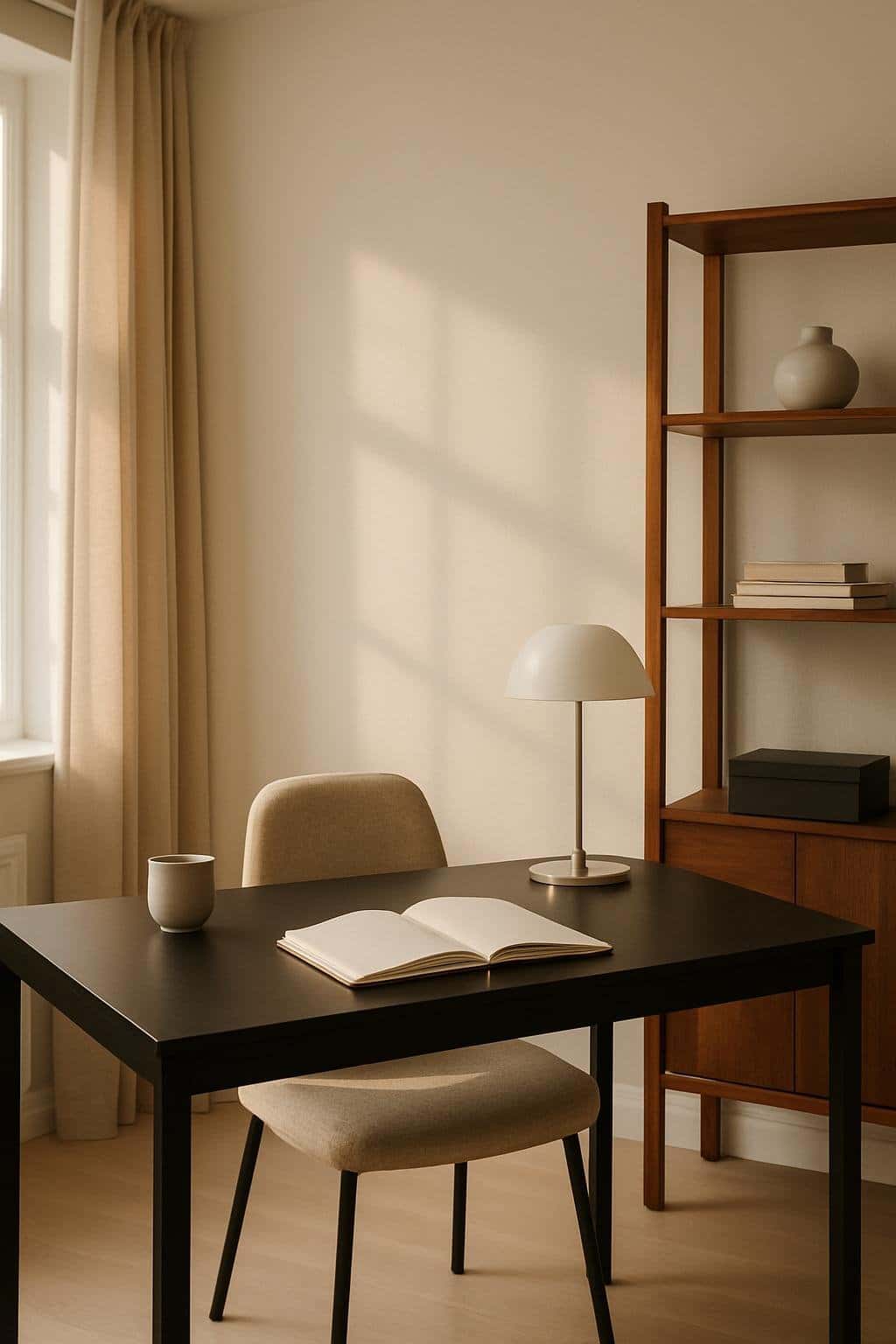
A black desk sets a refined foundation that pairs well with wood shelving and natural light. When positioned near a window, the warm tones of the setting sun soften the dark surfaces and bring out subtle textures in both furniture and decor.
Black Desk Creates A Modern, Sleek Look
A black desk establishes a strong focal point in the workspace. Its clean surface and neutral tone allow other elements to stand out without distraction. Many prefer matte finishes because they reduce glare and create a smooth, understated appearance.
Functionality matters as much as style. A desk with integrated cable management or built-in drawers helps maintain a tidy environment. Keeping the surface clear of clutter ensures that the desk remains visually sharp and practical.
Pairing the desk with ergonomic accessories enhances comfort. For example, a black monitor stand or keyboard tray maintains consistency in color while improving posture and workflow. This balance of design and utility makes the desk both visually appealing and highly functional.
Cherry Shelving Warms The Palette
Cherry wood shelving introduces warmth that contrasts with the cool, dark tones of the desk. The reddish-brown hues soften the starkness of black and add a natural element to the room. This combination prevents the workspace from feeling overly rigid or cold.
Shelving also provides useful vertical storage. Books, plants, and small decor items can be arranged to keep the desk clear while still within view. The wood grain itself becomes part of the visual interest, especially when paired with minimal black accessories.
A simple layout works best. For instance, alternating between open shelves for display and closed storage for less attractive items keeps the look balanced. The natural variation in cherry wood ensures that no two shelves look identical, adding subtle character to the workspace.
Golden Hour Light Highlights Textures
Golden hour light changes the atmosphere of a black-and-wood workspace. The low sun casts a warm glow that enhances the natural depth of cherry shelving while softening the dark finish of the desk. This interplay of light and shadow creates a layered, inviting effect.
Positioning the desk near a west-facing window maximizes this benefit. The angled light highlights small textures—matte surfaces, wood grain, or even fabric upholstery—making them more noticeable without overwhelming the space.
Layered lighting supports the effect after sunset. A desk lamp with a warm bulb can mimic the golden tones, ensuring that the workspace maintains its inviting quality even when natural light fades. This approach keeps the room functional while preserving its atmosphere.
Sage Desk With Evening Lamp Light
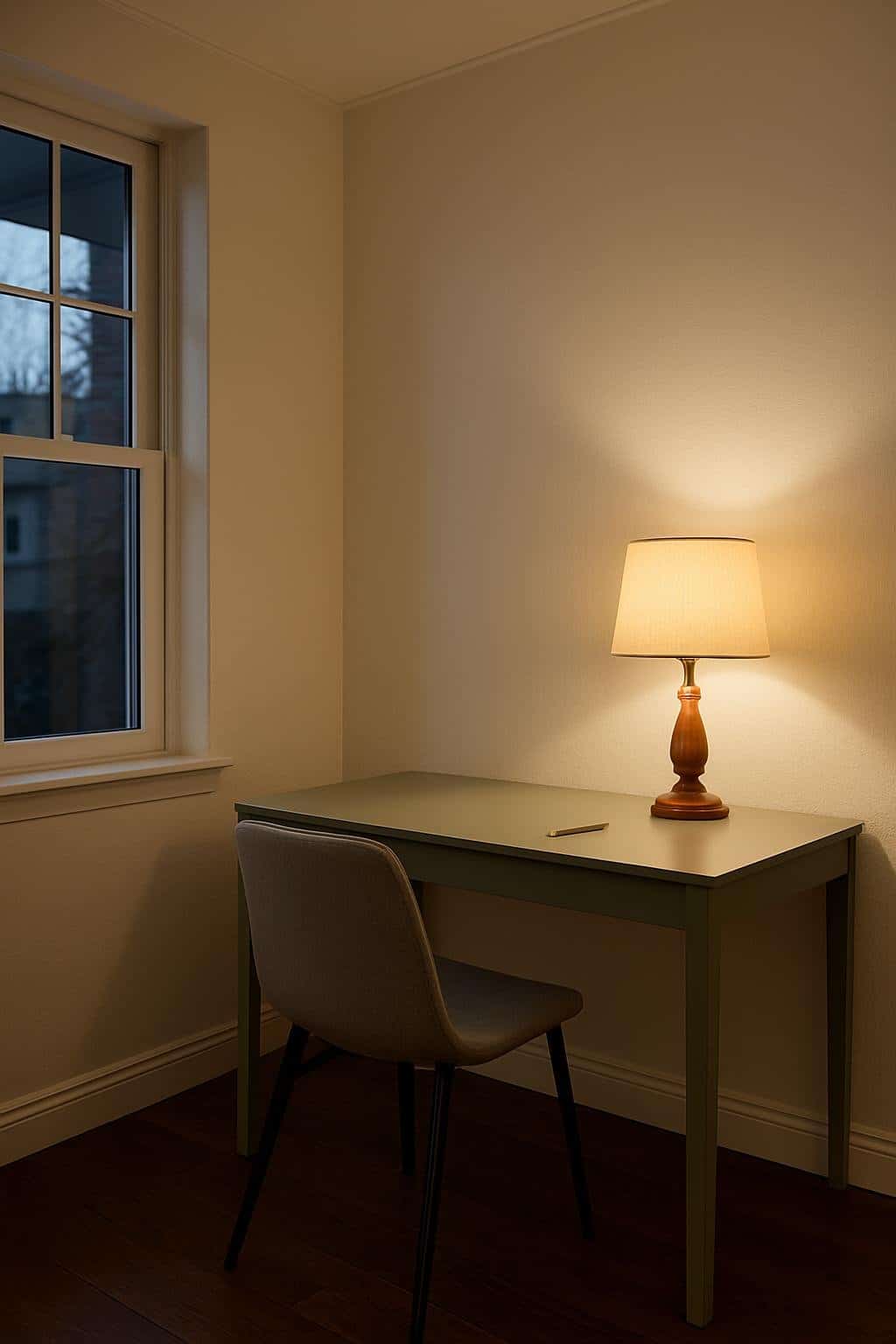
A sage green desk introduces warmth and balance into a home office, while neutral seating and thoughtful lighting ensure the space feels both functional and comfortable. Soft color choices and a calming lamp glow help create an environment that supports focus without feeling rigid.
Sage Desk Softens The Workspace
A desk in sage green tones provides a subtle shift from stark white or heavy wood finishes. The muted green acts as a middle ground—distinct enough to add personality but soft enough not to dominate the room.
This color works well for those who want a workspace that feels approachable. It pairs easily with natural wood, white shelving, or black metal accents. The result is a desk that blends into the room without appearing bland.
Sage also reduces visual strain. Unlike bright colors, it does not distract from tasks at hand. Instead, it creates a background that supports concentration.
For added function, desks in this shade often come in matte finishes, which help reduce glare from overhead lighting. The finish also resists fingerprints, keeping the surface clean during daily use.
Gray Chair Keeps The Palette Neutral
Pairing a sage desk with a gray chair maintains a balanced color palette. Gray works as a neutral anchor, preventing the space from leaning too heavily toward green tones.
A mid-tone gray chair complements sage without creating sharp contrast. Upholstered options add comfort for long work sessions, while mesh or molded chairs provide ergonomic support.
Material choice can shift the overall look.
- Fabric upholstery: adds softness and texture.
- Leather or faux leather: gives a more formal appearance.
- Mesh: improves airflow and suits modern setups.
The gray chair also adapts well to accessories. A simple cushion or throw can introduce subtle patterns while keeping the overall tone consistent. This flexibility makes gray a practical choice for those who may adjust decor over time.
Evening Lamp Creates A Calming Glow
An evening lamp placed on or near the desk provides task lighting while improving the room’s atmosphere. Sage or green-toned lamps blend with the desk, while neutral shades keep the focus on the light itself.
Warm LED bulbs around 2700K–3000K create a soft glow that reduces harsh shadows. Adjustable brightness settings allow the user to shift from focused work light to a gentler evening ambiance.
Placement matters. A lamp positioned slightly to the side of the monitor reduces glare on screens. A compact base also saves desk space, leaving room for notebooks or accessories.
For those with limited surface area, wall-mounted sconces in sage finishes offer a space-saving alternative. These provide the same calming light without crowding the desk.
The combination of soft color and warm illumination supports late-day tasks while preparing the room for a more relaxed evening setting.
Minimal Oak Desk With Cloudy Calm
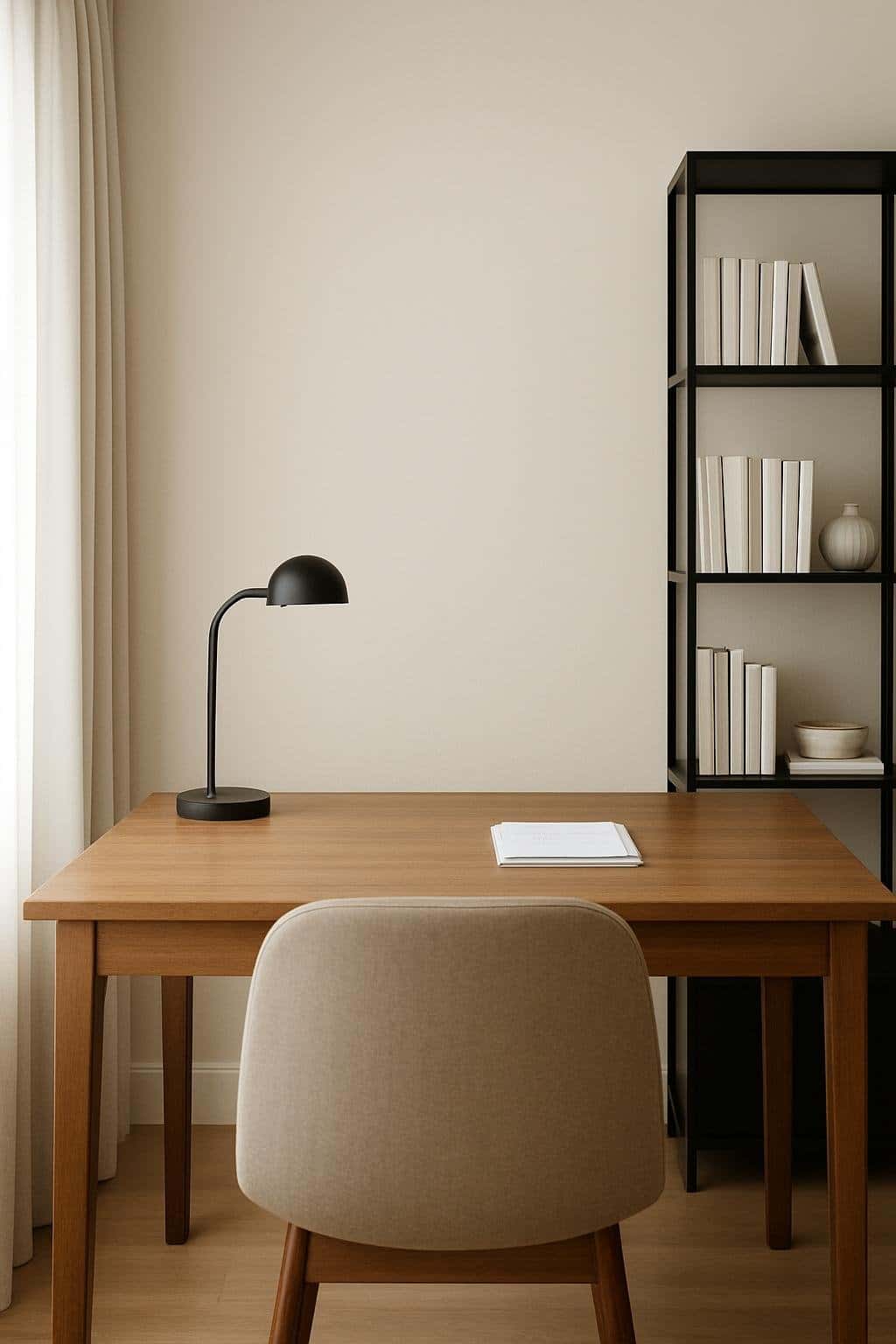
Natural oak surfaces, dark shelving, and diffused daylight work together to create a workspace that feels balanced and uncluttered. Each element contributes to both function and atmosphere, keeping the office efficient while maintaining a calm presence.
Oak Desk Adds Natural Simplicity
An oak desk provides a stable foundation with a clean, minimal design. Solid wood construction offers durability, while the natural grain adds subtle texture without overwhelming the space. The warm tone of oak pairs well with neutral palettes, keeping the room grounded.
Many oak desks feature discreet storage such as shallow drawers or side hooks. These details help reduce clutter, allowing documents, devices, and small tools to remain accessible but out of sight. A clear surface improves focus and reduces distraction.
Finishes such as matte oil or light stain preserve the natural look while protecting the surface. Choosing sustainably sourced oak ensures longevity and environmental responsibility. When paired with simple organizers, the desk becomes both practical and visually quiet.
Key benefits of oak desks:
- Long lifespan with proper care
- Neutral tone that blends with most interiors
- Natural tactile quality that enhances comfort
Black Shelving Sharpens The Design
Black shelving introduces contrast and structure against the lighter oak. The dark finish frames the workspace, giving definition without adding unnecessary decoration. Straight lines and simple brackets keep the look modern and restrained.
Shelves positioned above or beside the desk provide storage for books, reference materials, or decorative items. By keeping frequently used items within reach, the design supports efficiency without cluttering the desktop.
A combination of open shelving and closed boxes can balance accessibility with order. Black shelving also highlights lighter objects, making plants, ceramics, or wooden accessories stand out. This contrast creates visual rhythm while maintaining a minimal style.
Practical uses for shelving:
- Store work essentials at eye level
- Display a limited number of personal items
- Use closed containers for cables or small electronics
Cloudy Daylight Keeps The Workspace Serene
Soft daylight on overcast days creates diffused, even lighting that reduces glare on screens and paper. This type of illumination is easier on the eyes compared to direct sunlight or harsh artificial light.
Positioning the desk near a window allows natural light to fill the workspace without the need for strong overhead fixtures. Neutral curtains or blinds can filter brightness further, ensuring consistency throughout the day.
Cloudy light also softens shadows, which makes the environment feel less rigid. When combined with oak surfaces and black shelving, the muted brightness enhances the calm atmosphere. The result is a workspace that supports concentration while remaining visually comfortable.
Lighting tips:
- Align desk parallel to the window to avoid screen glare
- Use adjustable lamps on darker days
- Keep window areas clear to maximize natural light
Closing
A home office works best when it balances function with comfort. Good storage, proper lighting, and a thoughtful layout reduce distractions and make it easier to stay on task.
Small details also shape how welcoming the space feels. A fresh coat of paint, a few plants, or personal photos can soften the room without cluttering it.
Practical choices matter just as much as style. For example:
| Element | Purpose | Example |
|---|---|---|
| Storage | Keeps clutter out of sight | Cabinets, drawers, baskets |
| Lighting | Supports focus and comfort | Desk lamp with warm LED bulb |
| Seating | Encourages healthy posture | Adjustable office chair |
| Personal touch | Makes the space inviting | Family photos, artwork, greenery |
Simple habits help maintain the environment. Keeping a clear desk at the end of the day, returning items to storage, and limiting non-work objects prevent the room from becoming a catch‑all.
When design choices support both productivity and comfort, the office remains a place they want to use daily. This balance turns the space into a reliable setting for work while still feeling like part of the home.

